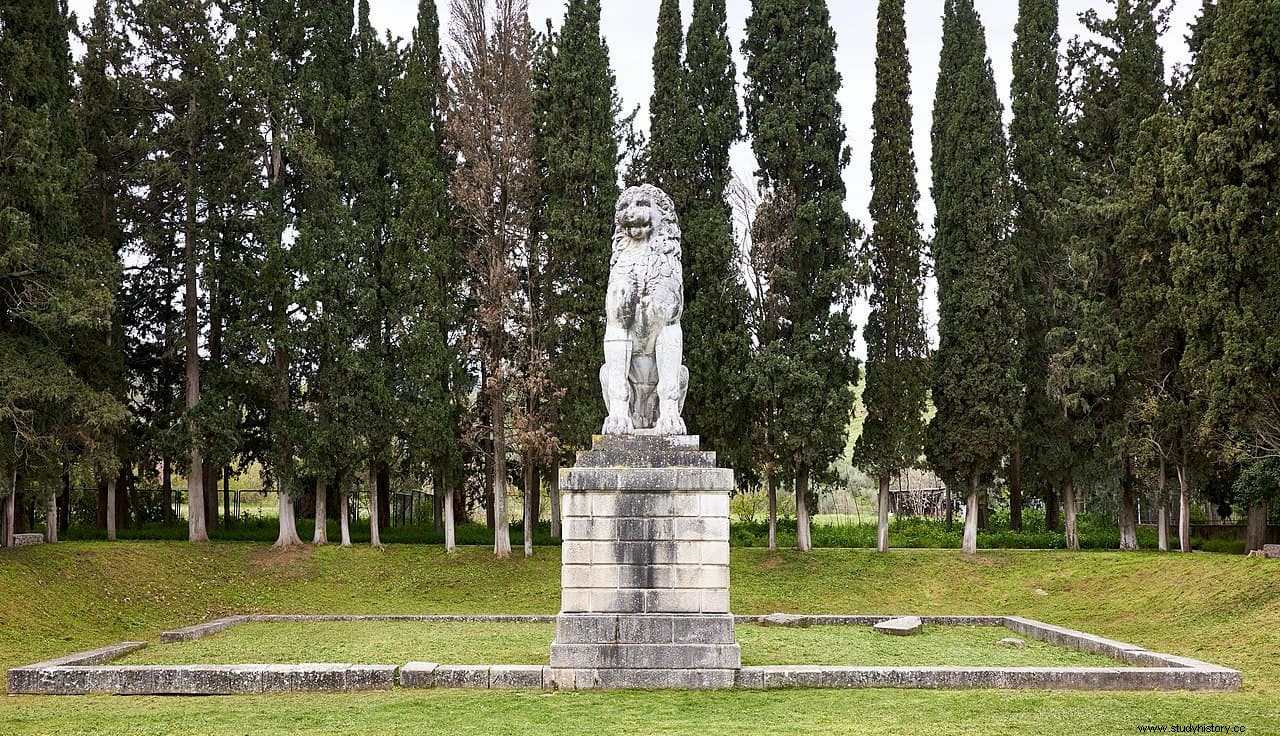Located on the shores of Lake Copaide (a large lake that was in the center of Boeotia, dried up in the 19th century) northwest of Thebes, the city of Chaeronea was already famous in ancient times for having been the scene of many important battles.
But without a doubt the best known of all was the one he faced in 338 B.C. to the troops of Philip II of Macedon, the father of Alexander the Great, with a coalition of various Greek city-states, commanded by Thebes and Athens. The outcome of the battle determined the future of Greece under Macedonian rule.

One of the most notable and remembered events of this battle was the defeat and total annihilation of what was considered the most lethal elite Greek force at the time, the Sacred Battalion of Thebes.
It was a unit made up of 150 pairs of male lovers that had been created by Górgidas, a contemporary Theban general and companion of Epaminondas, whose innovative tactics and final defeat of Sparta we have already discussed in previous articles.

In the Sacred Battalion, each couple was made up of an adult male (Heniochoi ) and another young man (paraibatai ). Chaeronea would be its only defeat in its entire history of nearly 33 years of existence.

Philip, who had been a captive at Thebes and knew the military tactics of the Boeotians, managed to put the combined Theban and Athenian army to flight. However, the Sacred Battalion stood firm and, surrounded, fell without giving up an iota of ground. Plutarch, who was born in Chaeronea (the city where he also died) tells that Philip, seeing the bodies piled up and knowing who they were, said:

According to Plutarco, that day the 300 members of the Sacred Battalion died. However, modern excavations of the Chaeronea communal tomb only found 254 skeletons.
This communal tomb is already mentioned by Pausanias in his Description of Greece:
Indeed, after the defeat Philip allowed the Thebans to bury their dead and, to mark the place, some two decades later, they erected a sculpture representing a lion about 6 meters high. However, by Plutarch's time it was no longer visible.

However, in one of those wonderful serendipities of archaeology, the architect George Ledwell Taylor together with Edward Cresy, John Sanders and the painter William Purser, during an excursion to Chaeronea on June 3, 1818, discovered some fragments, which they immediately suspected to be they could belong to the lion described by Pausanias. According to Taylor:

In the collection of the Victoria &Albert Museum there is a note from the diary of one of his companions, which states:
These fragments would soon be unearthed again, but not before Taylor and his companions tried to get them for the British Museum, and in 1820 they would be examined by new experts, such as the architect Wolfe, who would propose the correct restoration of the monument. Excavations from 1879 onwards revealed that the lion was originally on the edge of a peribolos or quadrangular enclosure. The original base of the lion was also found.

Also that, although the monument had been sinking progressively over the centuries, it had been broken into pieces during the war of independence of Greece, a few years after Taylor and his companions discovered it, leaving it in situ.
However, it would be necessary to wait another year, until 1880, for the archaeologist L.Phytalis to carry out deeper excavations that revealed the presence of human remains and would allow the ephor P.Stamatakis to personally find the entire mass grave. Six boxes of bones were taken to Athens. In addition to the 254 skeletons, there were also cremated remains of an undetermined number more, with the peculiarity that they seem to have been buried later.
As for the lion, despite the fact that Greece received numerous offers, both from Germany and the United Kingdom, to finance the restoration, they were all rejected.
Finally, the lion was re-erected in the same place where it was found in 1902, on the tomb of the Thebans of the Sacred Battalion. The reconstruction was paid for by the Order of Chaeronea, an organization that has defended the values of the Sacred Battalion for more than a hundred years, and the work carried out by the sculptor Lázaro Sochos, who used the ancient fragments by mounting them on a steel skeleton and filling the what was missing.

It stood on a marble plinth on the south side of the modern road, with the lion facing the nearby Macedonian burial mound, and surrounded by cypress trees. The lion's expression is serious, almost sad, but at the same time proud. Perhaps an expression of sorrow for the fallen.
But it can also have another meaning. At Thermopylae there was an earlier lion, marking the spot where Leonidas and his 300 Spartans had fallen. In 479 BC another 300 Thebans, the predecessors of the Sacred Battalion, had fallen fighting for Xerxes against the allies who defended the freedom of Greece. The previous year the Thebans had surrendered to the Persians at Thermopylae. Chaeronea's lion may have wanted to draw a parallel between the two episodes, in order to erase the Theban shame for having fought on the Persian side.
